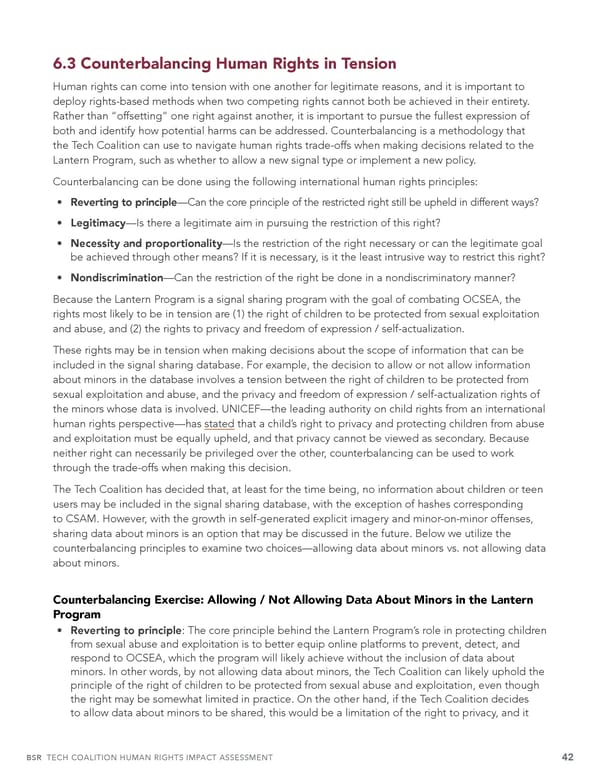6.3 Counterbalancing Human Rights in Tension Human rights can come into tension with one another for legitimate reasons, and it is important to deploy rights-based methods when two competing rights cannot both be achieved in their entirety. Rather than “offsetting” one right against another, it is important to pursue the fullest expression of both and identify how potential harms can be addressed. Counterbalancing is a methodology that the Tech Coalition can use to navigate human rights trade-offs when making decisions related to the Lantern Program, such as whether to allow a new signal type or implement a new policy. Counterbalancing can be done using the following international human rights principles: • Reverting to principle—Can the core principle of the restricted right still be upheld in different ways? • Legitimacy—Is there a legitimate aim in pursuing the restriction of this right? • Necessity and proportionality—Is the restriction of the right necessary or can the legitimate goal be achieved through other means? If it is necessary, is it the least intrusive way to restrict this right? • Nondiscrimination—Can the restriction of the right be done in a nondiscriminatory manner? Because the Lantern Program is a signal sharing program with the goal of combating OCSEA, the rights most likely to be in tension are (1) the right of children to be protected from sexual exploitation and abuse, and (2) the rights to privacy and freedom of expression / self-actualization. These rights may be in tension when making decisions about the scope of information that can be included in the signal sharing database. For example, the decision to allow or not allow information about minors in the database involves a tension between the right of children to be protected from sexual exploitation and abuse, and the privacy and freedom of expression / self-actualization rights of the minors whose data is involved. UNICEF—the leading authority on child rights from an international human rights perspective—has stated that a child’s right to privacy and protecting children from abuse and exploitation must be equally upheld, and that privacy cannot be viewed as secondary. Because neither right can necessarily be privileged over the other, counterbalancing can be used to work through the trade-offs when making this decision. The Tech Coalition has decided that, at least for the time being, no information about children or teen users may be included in the signal sharing database, with the exception of hashes corresponding to CSAM. However, with the growth in self-generated explicit imagery and minor-on-minor offenses, sharing data about minors is an option that may be discussed in the future. Below we utilize the counterbalancing principles to examine two choices—allowing data about minors vs. not allowing data about minors. Counterbalancing Exercise: Allowing / Not Allowing Data About Minors in the Lantern Program • Reverting to principle: The core principle behind the Lantern Program’s role in protecting children from sexual abuse and exploitation is to better equip online platforms to prevent, detect, and respond to OCSEA, which the program will likely achieve without the inclusion of data about minors. In other words, by not allowing data about minors, the Tech Coalition can likely uphold the principle of the right of children to be protected from sexual abuse and exploitation, even though the right may be somewhat limited in practice. On the other hand, if the Tech Coalition decides to allow data about minors to be shared, this would be a limitation of the right to privacy, and it BSR TECH COALITION HUMAN RIGHTS IMPACT ASSESSMENT 42
 Tech Coalition Human Rights Impact Assessment of the Lantern Program Page 41 Page 43
Tech Coalition Human Rights Impact Assessment of the Lantern Program Page 41 Page 43